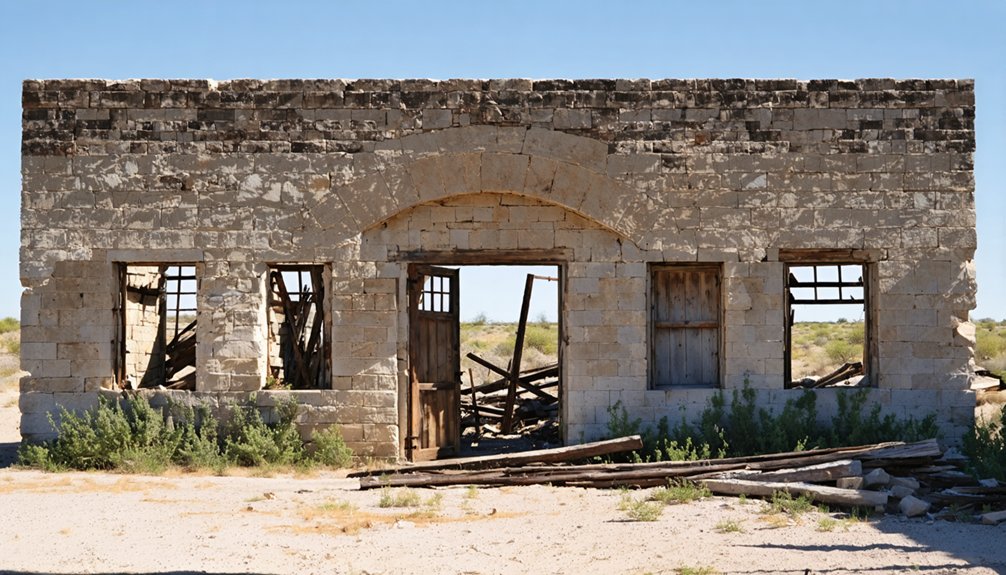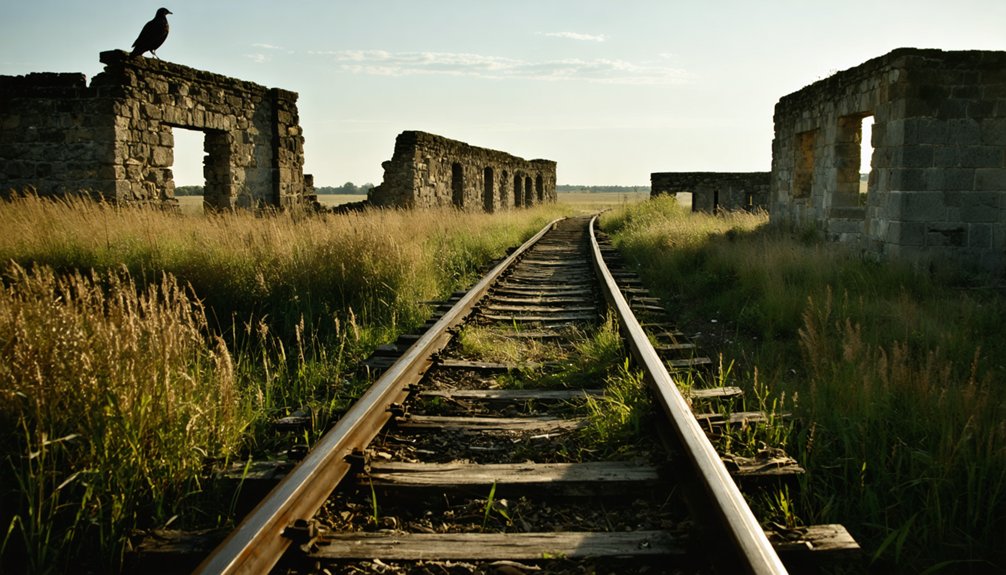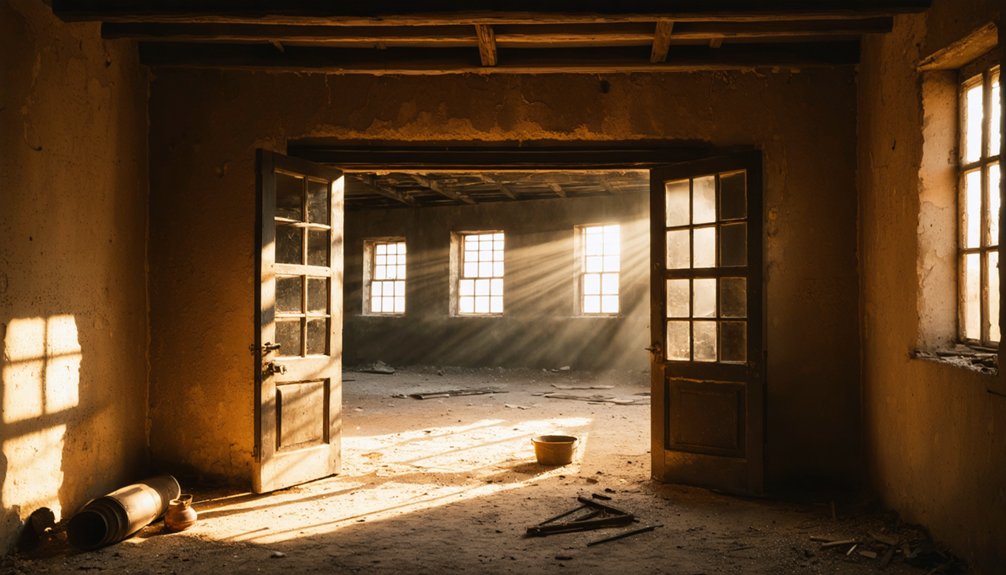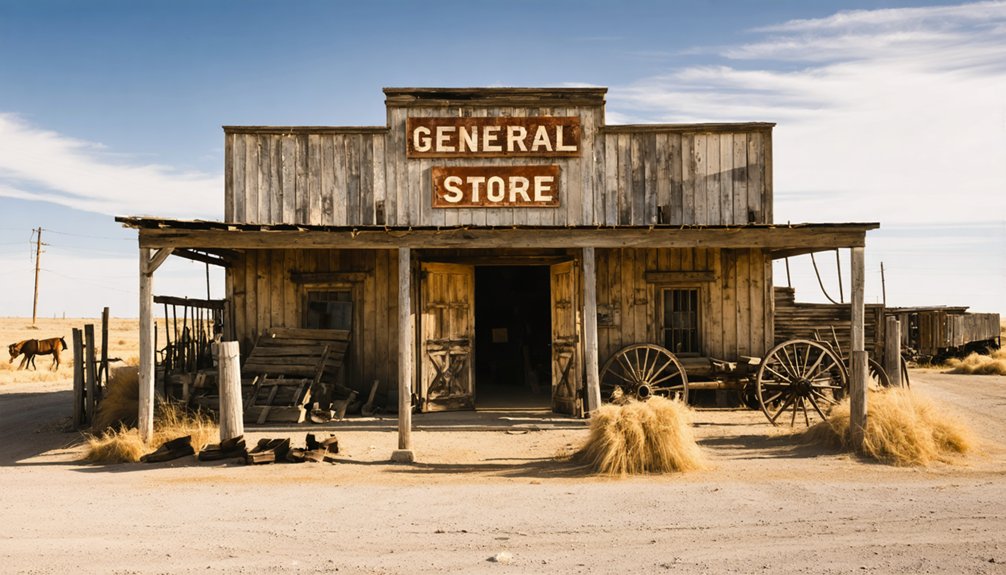You’ll find Fort Holland’s stone ruins on private ranch land near Valentine, Texas, where it once stood as a critical military outpost established in 1914. The fort served as a base for Colonel Langhorne’s 8th U.S. Cavalry during the Mexican Revolution, housing up to 400 troops who conducted border patrols against cross-border raids. While access requires permission today, the site’s remaining structures and Texas Historical Commission marker tell a compelling story of West Texas’s transformation from frontier battleground to border stronghold.
Key Takeaways
- Fort Holland, established in 1914 near Valentine, Texas, was abandoned in 1921 and now exists only as stone ruins on private ranch land.
- The fort’s remains include deteriorating barracks, officers’ quarters, and stone walls originally built for military defense during the Mexican Revolution.
- Access to Fort Holland’s ruins requires special permission as they are located on private property 12 miles west of Valentine.
- A Texas Historical Commission marker commemorates the site’s military significance and transformation from active fort to ghost town status.
- The fort’s remote location at Viejo Pass contributed to its abandonment after border tensions decreased following the Mexican Revolution.
The Birth of a Border Fortress
When cross-border raids intensified during the Mexican Revolution, the U.S. military established Camp Holland in 1914 at a strategic location known as Viejo Pass, roughly 12 miles west of Valentine, Texas. Built on the J.R. Holland Ranch, this outpost would become a significant base for military strategy against Mexican bandits, particularly Pancho Villa‘s forces.
You’ll find that Camp Holland’s transformation into Fort Holland in 1918 marked its evolution into a permanent military installation designed to address ongoing border conflicts. The impressive facility included two large barracks that could accommodate up to 400 soldiers at full capacity. The fort’s facilities expanded to include a mess hall and bakery to sustain the troops stationed there.
The fort served as an essential supply point for Colonel George T. Langhorne’s 8th U.S. Cavalry patrols along the Mexico-Texas border. As part of a broader network of frontier fortifications, it represented America’s determination to maintain sovereignty and protect citizens from cross-border violence during this turbulent period.
Military Life at Camp Holland
If you’d walked through Camp Holland during its heyday, you’d have witnessed soldiers engaged in rigorous daily drills and patrol preparations to maintain combat readiness.
The troops spent their days conducting equipment maintenance, working with pack trains, and preparing for border reconnaissance missions. Up to 400 soldiers could be housed in the camp’s two large barracks at any given time.
The camp’s strategic location at Viejo Pass made it an ideal base for the 8th U.S. Cavalry to launch rapid responses against Pancho Villa’s raiders and other Mexican bandits who threatened the border. The fort was actively defended until World War I ended in 1921, when it was officially closed.
Daily Routines and Duties
Life at Fort Holland followed a rigidly structured daily routine designed to uphold military readiness and efficiency.
You’d start your day with early morning roll calls and physical exercises before heading to your assigned duties. Whether you were manning guard rotations, maintaining the blacksmith shop, or handling supply management at the quartermaster store, every task supported the camp’s border patrol operations. The camp operated similarly to Camp Santa Helena, which was established for cavalry border patrols.
Your daily schedule included meals at the central mess hall, where fresh bread from the camp bakery supplemented your rations.
During designated work periods, you’d help maintain camp facilities and participate in essential cleaning duties. As evening approached, you’d prepare for night guard shifts or tend to your gear in the barracks, which housed up to 400 men.
Every activity guaranteed the fort remained combat-ready in this volatile frontier zone. Supporting Colonel George T. Langhorne’s cavalry required constant preparation and vigilance.
Training and Border Patrols
The military’s core mission at Fort Holland centered on intensive training for border patrol operations and counter-insurgency tactics against Pancho Villa’s forces.
You’d find soldiers engaged in rigorous training exercises focused on cavalry maneuvers and pack train logistics specifically designed for the rugged desert terrain.
- Scouting techniques and fort defense drills prepared troops for irregular warfare scenarios
- Coordinated patrol strategies with Texas Rangers to monitor illegal crossings and smuggling
- Specialized combat training to protect American ranches from cross-border raids
- Pack animal handling and maintenance skills for extended border surveillance missions
Training took place under harsh desert conditions, ensuring troops could effectively respond to border threats while maintaining constant readiness.
Similar to operations at Fort McIntosh in Laredo, troops conducted regular patrols along strategic sections of the Mexico border to maintain security.
The post’s blacksmith shop and quartermaster stores supported these critical military operations, keeping equipment and supplies ready for deployment.
Strategic Importance During Mexican Revolution
During the Mexican Revolution, Fort Holland‘s position near the Texas-Mexico border gave U.S. forces a critical advantage in defending against cross-border raids and revolutionary violence.
You’ll find that the fort’s strategic location enabled Colonel Langhorne’s 8th U.S. Cavalry to maintain rapid response capabilities through well-supplied pack trains and logistical support.
The fort’s establishment proved especially essential during Villa’s raids, as it served as a key operational base from which cavalry units could patrol vulnerable areas and protect American settlements from revolutionary incursions. Similar to Fort Anahuac’s outposts, Fort Holland helped increase military presence and control along important border regions. This approach to border defense echoed tactics used during the Mexican-American War, when U.S. forces established control over disputed territories.
Border Defense Operations
As Mexican revolutionary forces threatened the U.S. border in 1914, Camp Holland emerged as a significant military outpost, strategically positioned 12 miles west of Valentine, Texas in Viejo Pass.
You’ll find this fort played an essential role in border security, supporting the 8th U.S. Cavalry‘s efforts to deter cross-border raids. The post was constructed with stone and wood buildings that provided durability for its military operations.
The fort’s troop logistics capabilities included:
- Two large barracks housing up to 400 men
- Fundamental support facilities like a mess hall, bakery, and quartermaster store
- Pack trains that supplied cavalry patrols in rough terrain
- A thorough infrastructure with sewers and shower facilities
Despite limited manpower to patrol vast stretches of territory, Fort Holland served as a crucial fixed control point, helping protect American settlers and interests from revolutionary factions, including Pancho Villa’s forces.
Villa’s Raids Impact
Launching devastating cross-border raids in 1916, Pancho Villa’s forces struck U.S. territory with calculated precision, most prominently in the March 9 attack on Columbus, New Mexico, where over 600 Villistas inflicted significant casualties and destruction.
Villa’s Strategy brilliantly exploited the region’s complex terrain and local support networks, allowing his mobile forces to strike and retreat swiftly across the border.
You’ll find his raids weren’t merely acts of violence – they served as calculated moves to provoke U.S. intervention and undermine Carranza’s government.
The U.S. Response was swift but ultimately ineffective. President Wilson dispatched Pershing’s Punitive Expedition, mobilized National Guard units, and strengthened border defenses.
Despite an 11-month campaign, they couldn’t capture Villa, whose actions forever changed U.S.-Mexico relations and border security protocols.
Cavalry Response Tactics
The U.S. military’s response to Villa’s raids centered on an aggressive cavalry deployment strategy along the Texas-Mexico border.
You’ll find that cavalry maneuvers from bases like Camp Holland formed the backbone of America’s tactical formations against Mexican bandits and hostile forces. The mounted units provided rapid response capabilities across challenging terrain where infantry couldn’t effectively operate.
- Cavalry patrols covered strategic routes and passes, including Viejo Pass, to intercept and deter cross-border raiders.
- Scout networks provided early warning of incoming threats, allowing forces to quickly mobilize and engage.
- Units coordinated with Texas Rangers and customs officials to share intelligence and mount joint operations.
- Fortified outposts served as supply bases and fallback positions, supporting extended patrol missions and emergency responses.
Architecture and Building Design

While military necessity dictated Fort Holland’s austere design, its construction revealed sophisticated planning through the use of locally-sourced stone and timber materials.
The fort’s functional design emphasized durability and defense, with stone walls resistant to gunfire and wooden support structures that could be easily maintained. You’ll find military aesthetics reflected in every aspect, from the simple rectangular barracks to the strategically positioned mess hall.
The $16,000 construction incorporated frontier building techniques, featuring pitched roofs and minimal windows for maximum security.
Buildings were arranged for ideal troop movement and communication, with support structures like guardhouses positioned for defensive advantage.
The fort’s architecture adapted perfectly to Viejo Pass’s mountainous terrain while protecting soldiers from harsh weather extremes through practical, shelter-oriented design.
Daily Operations and Support Facilities
Operating as a self-contained military outpost, Fort Holland maintained sophisticated support facilities that sustained daily operations for up to 400 troops stationed along the Mexican border.
Fort Holland exemplified military self-sufficiency, with advanced facilities supporting hundreds of troops guarding the Mexican border.
The fort’s extensive supply logistics system guaranteed troops had everything needed for border defense missions and daily life.
Key facilities supporting troop morale and operational readiness included:
- A quartermaster store managing equipment and provisions
- A bakery producing fresh bread for stationed personnel
- A blacksmith shop maintaining weapons and metal tools
- A mess hall serving as the central dining facility
You’ll find the fort was designed for complete self-sufficiency, featuring both practical and comfort amenities.
From the shower house connected to a modern sewer system to the corral housing essential cavalry horses, every facility played a crucial role in maintaining combat readiness.
Notable Events and Conflicts

Established in 1914 amid rising tensions during the Mexican Revolution, Fort Holland served as a critical military outpost defending against cross-border raids and supporting Colonel George T. Langhorne‘s 8th U.S. Cavalry unit.
You’ll find the fort’s significance deeply rooted in protecting local communities from Mexican bandits, particularly after devastating raids on the Brite and Neville Ranches.
The fort’s location near Viejo Pass holds additional historical weight as the site of the last recorded battle between U.S. Cavalry and Apache Indians in Presidio County on June 12, 1880.
During its active years, border skirmishes kept the fort’s 400-man garrison busy with regular patrols and pack train operations until 1921, when the immediate threats diminished and operations were phased out.
The Final Years of Service
During its final years of service, Fort Holland shifted from a bustling military outpost to a strategic supply hub for the 8th U.S. Cavalry. The fort’s final operational phase included extensive infrastructure to support up to 400 soldiers, with facilities costing over $16,000 to construct.
- You’d find two large barracks, officers’ quarters, and essential support buildings like a guardhouse and bakery.
- The fort maintained modern amenities including a quartermaster store, sewer system, and shower house.
- Military operations focused primarily on defending against Mexican Revolution raiders and Pancho Villa’s bandits.
- By 1921, the military conversion was complete as border threats diminished after World War I.
The fort’s closure marked the end of an era, and you can still find its stone ruins standing as a symbol to early 20th-century border defense.
Preservation and Present-Day Ruins

While Fort Holland‘s military operations ceased in 1922, several stone ruins from the original compound still stand on private ranch land about six miles west of Valentine, Texas.
You’ll find remnants of barracks, officers’ quarters, and foundations of support buildings like the bakery, guardhouse, and blacksmith shop.
Visitor access requires permission from the property owners, and you’ll need to travel via Chilicote Ranch road.
There’s no formal ruin maintenance program in place – the site’s preservation relies mainly on the natural durability of stone construction, as wooden structures have largely deteriorated.
A Texas Historical Commission marker commemorates the fort’s significance as the location of the last U.S. cavalry-Indian battle and its role during the Mexican Revolution, though it provides no active protection for the remaining structures.
Historical Legacy in West Texas
Fort Holland stands as a tribute to America’s complex military history in West Texas, marking a pivotal change between the end of Apache conflicts and the turbulent years of the Mexican Revolution.
Fort Holland symbolizes the transformation of West Texas from a frontier battleground to a vital border stronghold during America’s westward expansion.
You’ll find its cultural significance deeply woven into the region’s development, where military presence shaped local communities and border relations.
- The fort’s $16,000 investment brought significant economic impact to Presidio County, establishing infrastructure and employment opportunities.
- Its strategic location in Viejo Pass demonstrates America’s commitment to territorial sovereignty and border security.
- The shift from cavalry outpost to civilian use reflects the evolution of frontier defense strategies.
- Today’s ruins serve as a reminder of the region’s transformation from contested borderlands to established American territory.
Frequently Asked Questions
Were Any Paranormal Activities Reported at Fort Holland During or After Operations?
You won’t find any documented ghost sightings during Fort Holland’s operation or after abandonment. Military records show no paranormal investigations, and the site lacks credible supernatural reports from historical or modern sources.
What Happened to the Military Equipment When the Fort Was Abandoned?
You’ll find military equipment was likely relocated to other bases or processed through DLA Disposition Services, which managed surplus disposal through reuse, recycling, or sale after Fort Holland’s abandonment.
Did Any Famous Historical Figures Besides Pancho Villa Visit Fort Holland?
You won’t find records of other famous visitors at Fort Holland beyond Pancho Villa’s adversarial connection. While it held historical significance for border defense, the fort didn’t attract notable historical figures.
Were There Any Archaeological Excavations Conducted at the Fort Site?
You won’t find documented archaeological findings at this site. While excavation techniques are standard in Texas historical research, there’s no evidence of formal digs or surveys at Fort Holland.
Did Soldiers’ Families Live at Fort Holland During Its Operational Years?
Probably not – primary sources point to purely military fort life. You’ll find no evidence of soldiers’ families residing there. Records show standard military barracks and officers’ quarters, without family housing facilities.
References
- https://fortwiki.com/Fort_Holland_(1)
- https://www.legendsofamerica.com/camp-holland-texas/
- https://mix941kmxj.com/see-how-two-texas-ghost-towns-battled-for-the-county-and-lost/
- https://kids.kiddle.co/Fort_Holland
- https://www.ghosttowns.com/states/tx/fortholland.html
- https://petticoatsandpistols.com/2017/08/15/rough-wooly-hidetown/
- https://en.wikipedia.org/wiki/List_of_ghost_towns_in_Texas
- https://www.texasescapes.com/WestTexasTowns/Fort-Holland-Texas.htm
- https://www.texasalmanac.com/articles/the-frontier-forts-of-texas
- https://en.wikipedia.org/wiki/Forts_of_Texas



